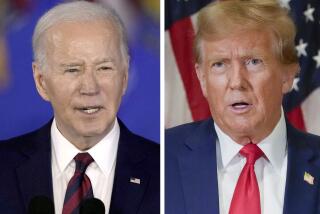Op-Ed: Yes, Trump’s hard-line immigration stance helped him win the election — but it could be his undoing

Ever since he announced his presidential campaign in July 2015, Donald Trump has made opposition to immigration central to his political strategy — and pundits have debated whether this strategy was effective. He won, of course, but did he win despite his aggressive rhetoric, or because of it?
Data from the recently released American National Election Study has finally provided an answer: Immigration was central to the election, and hostility toward immigrants animated Trump voters.
Comparing the results of the 2012 and 2016 ANES surveys shows that Trump increased his vote over Mitt Romney’s on a number of immigration-related issues. In 2012 and 2016, the ANES asked respondents their feelings toward immigrants in the country illegally. Respondents could rate them anywhere between 100 (most positive) or 0 (most negative). Among those with positive views (above 50), there was no change between 2012 and 2016, with Romney and Trump each receiving 22% of the vote. Among those who had negative views, however, Trump did better than Romney, capturing 60% of the vote compared with only 55% for Romney.
Attitudes toward immigrants in the country illegally speak to why some voters switched parties between 2012 and 2016. Among those who voted in both elections but didn’t switch their vote, the average rating of immigrants in the country illegally was 42. Among those who switched from Romney to Hillary Clinton, it was 41. But those who switched their vote from President Obama to Trump were much more negative, with an average rating of only 32.
Now that he is president and his immigration views can’t be dismissed as mere campaign rhetoric, a counter-mobilization may finally be manifesting itself.
However, Trump’s support wasn’t limited to just those who oppose immigrants residing in the country illegally — he also picked up votes among those who want to limit all immigration to the United States. In 2012, Romney received 58% of the vote among those who said they think that “the number of immigrants from foreign countries who are permitted to come to the United States” should be decreased. In 2016, Trump got 74% of the vote among those who held this view.
Overall, immigration represented one of the biggest divides between Trump and Clinton voters. Among Trump voters, 67% endorsed building a southern border wall and 47% of them favored it a great deal. In contrast, 77% of Clinton voters opposed building a wall and 67 % strongly opposed it.
Trump and Clinton voters were also deeply divided on the importance of speaking English. Eighty percent of Trump voters said that speaking English is very important for being “truly American,” but only 43 % of Clinton voters took the same view.
Nearly half of Trump voters (49%) favored changing the Constitution so that children born to undocumented immigrants would no longer automatically receive U.S. citizenship. Only 18% of Clinton voters took this view.
Trump voters, finally, said they don’t want to let Syrian refugees into the U.S., with 80% opposed to such a policy, compared with only 23% of Clinton voters. This result reflected Trump voters’ overall negative views of Muslims. On the 100-point scale mentioned above, 71% of Trump voters had a negative view of Muslims (50 or below). In contrast, only 31% of Clinton voters rated Muslims negatively. Trump’s hard-line stance on immigration, then, likely helped him win in 2016. But a word of caution: Many of his positions actually fall on the wrong side of public opinion.
In the ANES survey, a large majority of Trump voters (68%) said that “immigrants who were brought to the U.S. illegally as children and have lived here for at least 10 years and graduated high school” should be allowed to stay in the U.S. They want a border wall; they’re divided on the 14th Amendment — and yet, when push comes to shove, they don’t want to deport kids who have done nothing wrong.
Broadening out from Trump voters to the population at large, public opinion is even more dovish. Only 32% said they want to build a wall on the U.S.-Mexico border. Most (56%) oppose decreasing immigration levels. Only 21% said they think that immigration is bad for the economy.
Trump won in 2016 by mobilizing the minority of Americans with anti-immigration views — but only because he avoided an offsetting counter-mobilization by the majority of Americans with pro-immigration views. Now that he is president and his immigration views can’t be dismissed as mere campaign rhetoric, that counter-mobilization may finally be manifesting itself.
Widespread protests against Trump’s executive order barring individuals from several Muslim countries, congressional skepticism about the effectiveness and cost of Trump’s proposed wall, and increased awareness of the negative effect that his policies are having on U.S. businesses, schools and families suggest a growing backlash. Should that backlash develop and sustain itself, the immigration views that helped Trump in 2016 might prove to be his undoing.
Philip Klinkner is the James S. Sherman professor of government at Hamilton College.
Follow the Opinion section on Twitter @latimesopinion or Facebook
MORE FROM OPINION
Make California’s presidential primary great again
Trump’s populist revolution is already over — for now
More to Read
A cure for the common opinion
Get thought-provoking perspectives with our weekly newsletter.
You may occasionally receive promotional content from the Los Angeles Times.






